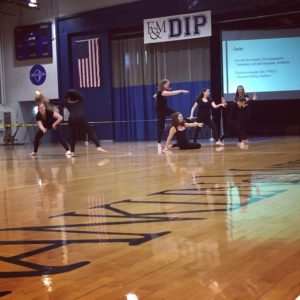By Shira Gould || Staff Writer
This week’s Common Hour was given by Doris Hall-Gulati, and her musical ensemble, Trio Clavino, Jennifer Conley, Lynn Brooks and Kim Jureckson with the Grant St. Dance Company. Through lecture and performance, they demonstrated an inherent connection between music and dance.
Trio Clavino, a musical group who wanted to merge dance with music, invited Franklin & Marshall dance students to perform with them. These students were responsible for the music that inspired the dances to be performed in this year’s Fall Dance Concert. The group plays contemporary music by current composers and they have performed internationally. Professor Jennifer Conley has been acknowledged for her mastering of modern dance. Lastly, Kim Jureckson has served as artistic director of Grant Street Dance Company for the past 18 years.
Lynn Brooks began the talk by introducing the fact that even toddlers physically react when they hear their favorite song. They bounce, clap, or smile, indicating the effect of music on physical reaction. Brooks stated that the Ancient Greek Orchestra was a dancing ground where performers sang in order to connect actors to the audience. Additionally, she acknowledged the use of storytelling ballets. Such ballets are meant to give meaning to a musical piece through physical movement.
Doris Hall Gulati then explained her inspiration to contact Franklin and Marshall’s Dance Company. She wanted to do a performance with dancers at the Ware Institute. Her group consists of violin, piano and clarinet, limiting the variety when it comes to the type of music they can play. They decided to play Stravinsky’s “The Soldier’s Tale.”
Jennifer Conley spoke about the inspiration behind her dancers’ performance. They began practicing outdoors with absolutely no music. Each dancer connected with different elements of nature, and created a movement to represent those parts. There was a representation of wind, fire and water, and two representations of earth. According to Conley, they were surprised by how well their movements matched the music. Although they needed to adjust the timing of some movements, they did not need to use any counting until the waltz section. They danced two excerpts from their piece: the tango and the devil dance.
Kim Jureckson spoke about the difference between dancing to live music versus a recording. According to Jureckson, her company only practiced with Trio Clavino’s live music once, which was nerve wracking to the dancers because each live musical performance can be slightly different. Thankfully, Jureckson explained, Trio Clavino’s recording was entirely accurate to the tempo and pauses in their live sound. She also told the audience about Anna Sokolow, who was an American dancer born to Russian Jewish immigrants, who did not support her endeavors in dance. She ended up creating the New Dance Group to establish dance as a method for social reform. She had dancers perform without music, and asked a composer to compose music relevant to the dance. These were the first modern dances to incorporate jazz music.
During the question and answers section, the dancers explained how dance makes them more aware of their daily movements. They explained that dance is an emotional outlet, but that particularly emotional compositions can also be draining.
Overall, they discussed that music and dance together creates a powerful combination that is emotionally expressive and charging.
First-year Shira Gould is the a staff writer. Her email is sgould@fandm.edu.

Photo courtesy of Erin Hallenbeck.